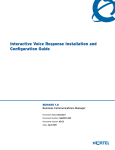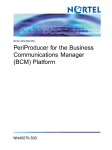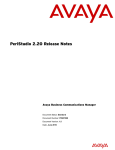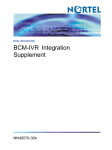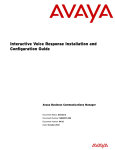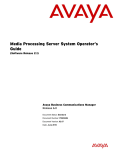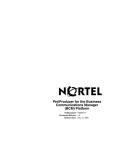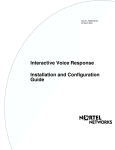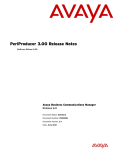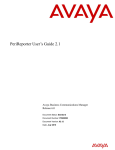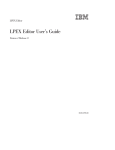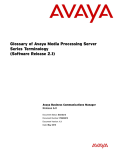Download Avaya Business Communications Manager Release 6.0 - BCM-IVR Integration Supplement User's Manual
Transcript
Avaya Business Communications Manager Release 6.0
Avaya BCM-IVR Integration
Supplement
NN40070-304
.
Document status: Standard
Document version: 03.01
Document date: 22 June 2010
©2010 Avaya Inc.
All Rights Reserved.
Notice
While reasonable efforts have been made to ensure that the information in this document is complete and accurate at
the time of printing, Avaya assumes no liability for any errors. Avaya reserves the right to make changes and
corrections to the information in this document without the obligation to notify any person or organization of such
changes.
Documentation disclaimer
Avaya shall not be responsible for any modifications, additions, or deletions to the original published version of
this documentation unless such modifications, additions, or deletions were performed by Avaya. End User agree
to indemnify and hold harmless Avaya, Avaya's agents, servants and employees against all claims, lawsuits,
demands and judgments arising out of, or in connection with, subsequent modifications, additions or deletions to
this documentation, to the extent made by End User.
Link disclaimer
Avaya is not responsible for the contents or reliability of any linked Web sites referenced within this site or
documentation(s) provided by Avaya. Avaya is not responsible for the accuracy of any information, statement or
content provided on these sites and does not necessarily endorse the products, services, or information described or
offered within them. Avaya does not guarantee that these links will work all the time and has no control over the
availability of the linked pages.
Warranty
Avaya provides a limited warranty on this product. Refer to your sales agreement to establish the terms of the
limited warranty. In addition, Avaya’s standard warranty language, as well as information regarding support for
this product, while under warranty, is available to Avaya customers and other parties through the Avaya Support
Web site: http://www.avaya.com/support
Please note that if you acquired the product from an authorized reseller, the warranty is provided to you by said
reseller and not by Avaya.
Licenses
THE SOFTWARE LICENSE TERMS AVAILABLE ON THE AVAYA WEBSITE, HTTP://SUPPORT.AVAYA.COM/LICENSEINFO/ ARE APPLICABLE TO ANYONE WHO DOWNLOADS, USES AND/OR INSTALLS AVAYA
SOFTWARE, PURCHASED FROM AVAYA INC., ANY AVAYA AFFILIATE, OR AN AUTHORIZED AVAYA RESELLER
(AS APPLICABLE) UNDER A COMMERCIAL AGREEMENT WITH AVAYA OR AN AUTHORIZED AVAYA
RESELLER. UNLESS OTHERWISE AGREED TO BY AVAYA IN WRITING, AVAYA DOES NOT EXTEND THIS
LICENSE IF THE SOFTWARE WAS OBTAINED FROM ANYONE OTHER THAN AVAYA, AN AVAYA AFFILIATE OR
AN AVAYA AUTHORIZED RESELLER, AND AVAYA RESERVES THE RIGHT TO TAKE LEGAL ACTION AGAINST
YOU AND ANYONE ELSE USING OR SELLING THE SOFTWARE WITHOUT A LICENSE. BY INSTALLING,
DOWNLOADING OR USING THE SOFTWARE, OR AUTHORIZING OTHERS TO DO SO, YOU, ON BEHALF
OF YOURSELF AND THE ENTITY FOR WHOM YOU ARE INSTALLING, DOWNLOADING OR USING THE
SOFTWARE (HEREINAFTER REFERRED TO INTERCHANGEABLY AS “YOU” AND “END USER”), AGREE TO
THESE TERMS AND CONDITIONS AND CREATE A BINDING CONTRACT BETWEEN YOU AND AVAYA INC.
OR THE APPLICABLE AVAYA AFFILIATE (“AVAYA”).
Copyright
Except where expressly stated otherwise, no use should be made of the Documentation(s) and Product(s) provided
by Avaya. All content in this documentation(s) and the product(s) provided by Avaya including the selection,
arrangement and design of the content is owned either by Avaya or its licensors and is protected by copyright and
other intellectual property laws including the sui generis rights relating to the protection of databases. You may not
modify, copy, reproduce, republish, upload, post, transmit or distribute in any way any content, in whole or in part,
including any code and software. Unauthorized reproduction, transmission, dissemination, storage, and or use
without the express written consent of Avaya can be a criminal, as well as a civil offense under the applicable law.
Third Party Components
Certain software programs or portions thereof included in the Product may contain software distributed under
third party agreements ("Third Party Components"), which may contain terms that expand or limit rights to use
certain portions of the Product ("Third Party Terms"). Information regarding distributed Linux OS source code
(for those Products that have distributed the Linux OS source code), and identifying the copyright holders of the
Third Party Components and the Third Party Terms that apply to them is available on the Avaya Support Web
site: http://support.avaya.com/Copyright.
Trademarks
The trademarks, logos and service marks (“Marks”) displayed in this site, the documentation(s) and product(s)
provided by Avaya are the registered or unregistered Marks of Avaya, its affiliates, or other third parties. Users are
not permitted to use such Marks without prior written consent from Avaya or such third party which may own the
Mark. Nothing contained in this site, the documentation(s) and product(s) should be construed as granting, by
implication, estoppel, or otherwise, any license or right in and to the Marks without the express written permission
of Avaya or the applicable third party. Avaya is a registered trademark of Avaya Inc. All non-Avaya trademarks
are the property of their respective owners.
Downloading documents
For the most current versions of documentation, see the Avaya Support. Web site: http://www.avaya.com/support
Contact Avaya Support
Avaya provides a telephone number for you to use to report problems or to ask questions about your product. The
support telephone number is 1-800-242-2121 in the United States. For additional support telephone numbers,
see the Avaya Web site: http://www.avaya.com/support
5
Revision History
March 2007
Standard 1.2
February 2007
Standard 1.1. This version contains a new chapter on backing up folders
in Avaya BCM.
July 2006
Standard 1.0.
Avaya Business Communications Manager Release 6.0
Avaya BCM-IVR Integration Supplement
NN40070-304 03.01 Standard
4.0 22 June 2010
.
6 Revision History
Avaya Business Communications Manager Release 6.0
Avaya BCM-IVR Integration Supplement
NN40070-304 03.01 Standard
4.0 22 June 2010
.
7
Contents
Preface
9
Scope 9
Intended Audience 9
Customer service 9
Navigation 9
Getting technical documentation 10
Getting product training 10
Getting help from a distributor or reseller 10
Getting technical support from the Avaya Web site 10
How to Use This Manual 10
Organization of This Manual 10
Conventions Used in This Manual 11
Solaris and Windows Conventions 13
Two-Button (Windows) vs. Three-Button (Solaris) Mouse 13
Trademark Conventions 13
Chapter 1 Introduction to the Avaya BCM-IVR Integration
15
The Avaya Business Communications Manager (Avaya BCM) - Interactive Voice
Response (IVR) Integration 15
What functionality does the IVR integration add to the Avaya BCM? 15
Documentation issues 16
Chapter 2 COMMGR for the Avaya BCM Platform
17
Documentation issues and workarounds 17
Installation issues and workarounds 18
Functionality issues and workarounds 19
Chapter 3 PeriView for the Avaya BCM Platform
21
Documentation issues and workarounds 21
Functionality issues and workarounds 22
Additional alarms for the Avaya BCM platform 23
Issuing commands to the Avaya BCM 24
Chapter 4 PeriReporter for the Avaya BCM Platform
Configuring windows workstations to retrieve statistics 27
Configuring the collection stations 28
Changing the monitored Avaya BCM nodes 29
Avaya Business Communications Manager Release 6.0
Avaya BCM-IVR Integration Supplement
NN40070-304 03.01 Standard
4.0 22 June 2010
.
27
8 Contents
Documentation issues and workarounds 29
Functionality issues and workarounds 30
Phone Line Statistics reports variances for the Avaya BCM platform
Chapter 5 Folders on the Avaya BCM Platform
31
33
Backing up folders 33
Folders provided for use by IVR developers 34
Index
Avaya Business Communications Manager Release 6.0
Avaya BCM-IVR Integration Supplement
NN40070-304 03.01 Standard
4.0 22 June 2010
.
35
9
Preface
Scope
Avaya Business Communications Manager (Avaya BCM) is a
communications platform that delivers voice processing, business telephony
applications, and data networking services. To extend these capabilities,
has integrated existing IVR software to run on the Avaya BCM platform.
The Avaya BCM-IVR Integration manual explains variances in COMMGR,
PeriView, and PeriReporter software functionality when it is integrated with
Avaya BCM. It is not meant to replace their individual user guides; it is
meant only to be used as a supplement to them.
Intended Audience
This guide assumes that the user has completed an on-site system
familiarization training program conducted as part of the initial system
installation. In addition, they should be familiar with other site-specific
operating procedures relating to the Avaya BCM that are due to specific
application functions performed by the Avaya BCM and with any other
equipment to which the Avaya BCM may be connected. Basic knowledge of
your operating system(s) software is also assumed.
Customer service
Visit the Avaya Web site to access the complete range of services and
support that Avaya provides. Go to www.avaya.com or go to one of the
pages listed in the following sections.
Navigation
•
"Getting technical documentation" (page 10)
•
"Getting product training" (page 10)
•
"Getting help from a distributor or reseller" (page 10)
•
"Getting technical support from the Avaya Web site" (page 10)
Avaya Business Communications Manager Release 6.0
Avaya BCM-IVR Integration Supplement
NN40070-304 03.01 Standard
4.0 22 June 2010
.
10 Preface
Getting technical documentation
To download and print selected technical publications and release notes
directly from the Internet, go to www.avaya.com/support.
Getting product training
Ongoing product training is available. For more information or to register,
you can access the Web site at www.avaya.com/support. From this Web
site, you can locate the Training contacts link on the left-hand navigation
pane.
Getting help from a distributor or reseller
If you purchased a service contract for your Avaya product from a distributor
or authorized reseller, contact the technical support staff for that distributor
or reseller for assistance.
Getting technical support from the Avaya Web site
The easiest and most effective way to get technical support for
Avaya products is from the Avaya Technical Support Web site at
www.avaya.com/support.
How to Use This Manual
This manual uses many standard terms relating to computer systems,
software application functions, and the Internet. However, it contains some
terminology that can be explained only in the context of the MPS Series.
Refer to the Glossary of Avaya Media Processing Server Series Terminology
for definitions of MPS Series specific terms.
Read this manual from start to finish at least once. When you are familiar
with the document, you can use the Table of Contents to locate topics of
interest for reference and review.
If you are reading this document online, use the cross-reference links
(shown in blue) to quickly locate related topics. Position your cursor over the
cross-reference link and click once. Click any point in a Table of Contents
entry to move to that topic. Click the page number of any Index entry to
access that topic page.
Familiarize yourself with various specialized textual references within the
manual see "Conventions Used in This Manual" (page 11).
Note: Periphonics is now part of . The name Periphonics, and variations
thereof, appear in this manual only in reference to a product (for
example, the PERImps package, the perirev command, and so on).
Organization of This Manual
This manual is organized in the following way:
Avaya Business Communications Manager Release 6.0
Avaya BCM-IVR Integration Supplement
NN40070-304 03.01 Standard
4.0 22 June 2010
.
Conventions Used in This Manual 11
Chapter 1 — Introduction to the Avaya BCM-IVR Integration
Overviews the Avaya BCM and what functionality the IVR integration brings
to Avaya BCM. Explains how to access documentation on Helmsman.
Chapter 2 — COMMGR for the Avaya BCM Platform
Discusses documentation, installation, and functionality variances in
COMMGR for the Avaya BCM platform.
Chapter 3 — PeriView for the Avaya BCM Platform
Discusses documentation and functionality variances in PeriView for the
Avaya BCM platform. Explains alarms that have been added for the Avaya
BCM, and how to issue commands.
Chapter 4 — PeriReporter for the Avaya BCM Platform
Discusses documentation, functionality, and Phone Line Statistics reports
variances in PeriReporter for the Avaya BCM platform.
Chapter 5— Folders on the Avaya BCM Platform
Discusses folders included in the process of backing up IVR Data and IVR
Configuration information through the Business Element Manager.
Conventions Used in This Manual
This manual uses different fonts and symbols to differentiate between
document elements and types of information. These conventions are
summarized in the following table.
Conventions Used in This Manual
Notation
Description
Normal text
Normal text font is used for most of the document.
important term
The Italics font introduces new terms, highlights meaningful
words or phrases, or distinguishes specific terms from
nearby text.
system
command
This font indicates a system command or its arguments.
Enter such keywords exactly as shown (that is, do not fill in
your own values).
a. Windows and the flying Window logo are either trademarks or registered
trademarks of Microsoft Corporation.
b. Solaris® is a registered trademark of The Open Group in the U.S. and
other countries.
Avaya Business Communications Manager Release 6.0
Avaya BCM-IVR Integration Supplement
NN40070-304 03.01 Standard
4.0 22 June 2010
.
12 Preface
Notation
Description
command,
condition
and alarm
Command, Condition and Alarm references appear on
the screen in magenta text and reference the Command
Reference Manual, the MPS Developer User’s Guide, or
the Alarm Reference Manual, respectively. Refer to these
documents for detailed information about Commands,
Conditions, and Alarms.
file name /
directory
This font highlights the names of disk directories, files, and
extensions for file names. It also shows what is displayed
on a text-based screen (for example, to show the contents
of a file.)
on-screen field
This font indicates field labels, on-screen menu buttons, and
action buttons.
<KEY NAME>
A term that appears within angled brackets denotes a
terminal keyboard key, a telephone keypad button, or a
system mouse button.
Book Reference
This font indicates the names of other publications
referenced within the document.
cross-reference
A cross-reference appears on the screen in blue. Click
the cross- reference to access the referenced location. A
cross-reference that refers to a section name accesses the
first page of that section.
The Note icon identifies notes, important facts, and other
keys to understanding.
The Caution icon identifies procedures or events that require
special attention. The icon indicates a warning that serious
problems may arise if the stated instructions are not followed
implicitly.
The flying Window icon identifies procedures or events that
apply to the Windows operating system only.a
The Solaris icon identifies procedures or events that apply
to the Solaris operating system only.b
a. Windows and the flying Window logo are either trademarks or registered
trademarks of Microsoft Corporation.
b. Solaris® is a registered trademark of The Open Group in the U.S. and
other countries.
Avaya Business Communications Manager Release 6.0
Avaya BCM-IVR Integration Supplement
NN40070-304 03.01 Standard
4.0 22 June 2010
.
Trademark Conventions
13
Solaris and Windows Conventions
This manual depicts examples (command line syntax, configuration
files, and screen shots) in Solaris format. Windows-specific commands,
procedures, or screen shots are shown when required. The following table
lists general operating system conventions used with either the Solaris or
Windows operating system.
Solaris
Windows
Environment
$PPROHOME
%PPROHOME%
Paths
$PPROHOME/bin
%PPROHOME%\bin
Command
<command> &
start /b <command>
Two-Button (Windows) vs. Three-Button (Solaris) Mouse
Trademark Conventions
The following trademark information is presented here and applies
throughout for third party products discussed within this manual.
Trademarking information is not repeated hereafter.
Solaris® and Motif® are registered trademarks of The Open Group in the U.S.
and other countries.
Solaris, SunOS, OpenWindows, SPARC, and UltraSPARC are trademarks
or registered trademarks of Sun Microsystems, Inc. in the United States
and other countries.
Microsoft, MSSQL, Windows, Internet Explorer, and the Flying Windows logo
are either trademarks or registered trademarks of Microsoft Corporation.
Oracle® is a registered trademark of Oracle Corporation.
Sybase™ and SYBASE™ are trademarks of Sybase, Inc. or its subsidiaries.
Avaya Business Communications Manager Release 6.0
Avaya BCM-IVR Integration Supplement
NN40070-304 03.01 Standard
4.0 22 June 2010
.
14 Preface
Informix® and INFORMIX® are registered trademarks of Informix Corporation
or its affiliates.
Avaya Business Communications Manager Release 6.0
Avaya BCM-IVR Integration Supplement
NN40070-304 03.01 Standard
4.0 22 June 2010
.
15
Chapter 1
Introduction to the Avaya BCM-IVR
Integration
This chapter covers:
1. The Avaya BCM-IVR Integration
2. What functionality does the IVR integration add to the Avaya BCM?
The Avaya Business Communications Manager (Avaya BCM) Interactive Voice Response (IVR) Integration
Avaya Business Communications Manager (Avaya BCM) is a fully-integrated
communication system for small businesses, government and retail
networks, and enterprise branch offices.
Interactive Voice Response is a telecommunications system that uses a
prerecorded database of voice messages to present options to a user,
typically over telephone lines. Users can input information using the keys
on their touchtone phones.
The following terms describe the relationship of the Avaya BCM product with
the integration of the IVR platform.
•
BCM 4.0: hardware platform running Carrier Grade Linux.
•
BCM-IVR 2.1: MPS runtime environment on the BCM 4.0 hardware
platform.
•
BCM-IVR: MPS 2.1 software tools (PeriView, PeriProducer,
PeriReporter) that work with the Avaya BCM.
What functionality does the IVR integration add to the Avaya BCM?
The IVR solution is a suite of products that allows businesses to create
applications that callers use to access information, by responding to a
series of prompts through their touchtone phones.
Avaya Business Communications Manager Release 6.0
Avaya BCM-IVR Integration Supplement
NN40070-304 03.01 Standard
4.0 22 June 2010
.
16 Chapter 1 Introduction to the Avaya BCM-IVR Integration
The IVR applications are developed for specific customer needs and in
many cases are integrated with databases to enable real-time queries and
updates. Some examples of IVR applications are:
•
A credit card company’s application that lets customers access their
accounts, receive real-time account balances, and transfer funds
between accounts.
•
A bus station’s IVR application that lets customers book seats on a
trip or review projected departure times.
•
A bookstore’s application that lets customers hear store hours,
purchase books, and check the delivery of an existing order.
IVR administration is handled using PeriView (see Chapter 3) and
PeriReporter (see Chapter 4). Applications are created using PeriProducer.
Host communications are managed using COMMGR (see Chapter 2).
Variances in functionality between the MPS and the Avaya BCM-IVR
integration are detailed throughout this document.
Note: For information on PeriProducer’s variations in functionality for
the Avaya BCM-IVR integration, see the PeriProducer for the Avaya
BCM-IVR Platform manual.
Documentation issues
Issue
Documentation currently refers to hardware as the MPS.
Wherever the documentation uses MPS, assume that this refers to the Avaya
BCM.
Issue
Avaya BCM is considered an MPS component.
Wherever there are references to an MPS component, assume that this refers
to a Avaya BCM component.
Avaya Business Communications Manager Release 6.0
Avaya BCM-IVR Integration Supplement
NN40070-304 03.01 Standard
4.0 22 June 2010
.
17
Chapter 2
COMMGR for the Avaya BCM Platform
This chapter covers:
1. Documentation issues and workarounds
2. Installation issues and workarounds
3. Functionality issues and workarounds
Documentation issues and workarounds
Issue
Documentation currently refers to hardware as the MPS.
Wherever the documentation uses MPS, assume that this refers to the Avaya
Business Communications Manager (Avaya BCM).
Issue
Avaya BCM is considered an MPS component.
Wherever there are references to an MPS component, assume that this refers
to a Avaya BCM component.
Issue
Not all documentation can be found on the Avaya BCM.
PDF versions of documentation are located on the Website, www.avaya.com.
Issue
PeriDoc is not available for the Avaya BCM.
Avaya Business Communications Manager Release 6.0
Avaya BCM-IVR Integration Supplement
NN40070-304 03.01 Standard
4.0 22 June 2010
.
18 Chapter 2 COMMGR for the Avaya BCM Platform
Use the PDF versions of documentation found on the website, www.avaya.com.
Installation issues and workarounds
Issue
You need to obtain a license (keycode) and add it to the Avaya BCM to
use COMMGR.
If you are installing a new Avaya BMC-IVR system, see the IVR Installation and
Configuration Guide to learn how to obtain a keycode from the KRS (Keycode
Retrieval System).
If you are upgrading your current Avaya BMC-IVR system to BMC-IVR 2.1, contact
Technical Support (1-800-4). Select option 5 > option 1.
Tell the Technical Support Prime that you need assistance in producing a keycode
for Avaya BMC-IVR. When you are connected with a Level 2 Keycode Support
Prime, ask for help in producing a BCM Host Communications keycode (license
file).
To receive the BCM Host Communications keycode, you must provide the
Level 2 Keycode Support Prime with the following:
•
the BCM MAC address
•
the existing IVR 1.1 license file (you must send an e-mail with the
existing license file attached to the Level 2 Keycode Support Prime)
•
the authorization numbers obtained from purchasing the
PeriProducer (NTAB4211) and PeriStudio (NTAB4210).
To find out how to obtain the BCM MAC address and the existing IVR 1.1
license file, see the BMC-IVR 2.1 Upgrade Guide.
When you receive an e-mail containing the keycode from the Level 2
Technical Support Prime, you are ready to load the keycode to the keycode
directory in Business Element Manager.
1. Launch Business Element Manager.
2. In the Task Navigation panel, select the Configuration tab.
3. Expand the Applications folder and click IVR.
4. Enter the node number for the IVR.
5. Click Load Keycode File and load the keycode received from the
Level 2 Technical Support Prime.
Avaya Business Communications Manager Release 6.0
Avaya BCM-IVR Integration Supplement
NN40070-304 03.01 Standard
4.0 22 June 2010
.
Functionality issues and workarounds
19
After the keycode has installed, the IVR service restarts automatically.
Functionality issues and workarounds
Issue
Only the TN3270 and ATTE host protocols are supported on the Avaya
BCM. No other protocols are currently supported.
Use only TN3270 or ATTE host protocols. You can also use VCTPD as an
interface to TCP/IP hosts. See the IVR Installation and Configuration Guide if you
are installing a BMC-IVR system for the first time. See the BMC-IVR 2.1 Upgrade
Guide if you are upgrading an existing system to BMC-IVR 2.1.
Issue
COMMGR is not supported on the Solaris and Windows platforms for Avaya
BCM.
COMMGR is supported on the Linux node for the Avaya BCM.
Avaya Business Communications Manager Release 6.0
Avaya BCM-IVR Integration Supplement
NN40070-304 03.01 Standard
4.0 22 June 2010
.
20 Chapter 2 COMMGR for the Avaya BCM Platform
Avaya Business Communications Manager Release 6.0
Avaya BCM-IVR Integration Supplement
NN40070-304 03.01 Standard
4.0 22 June 2010
.
21
Chapter 3
PeriView for the Avaya BCM Platform
This chapter covers:
1. Documentation issues and workarounds
2. Functionality issues and workarounds
3. Additional alarms for the Avaya BCM platform
4. Issuing commands to the Avaya BCM
Documentation issues and workarounds
Issue
Documentation currently refers to hardware as the MPS.
Wherever the documentation uses MPS, assume that this refers to the Avaya
Business Communications Manager (Avaya BCM).
Issue
Avaya BCM is considered an MPS component.
Wherever there are references to an MPS component, assume that this refers
to a Avaya BCM component
Issue
Not all documentation can be found on the Avaya BCM.
PDF versions of documentation are located on the website, www.avaya.com.
Issue
PeriDoc is not available for the Avaya BCM.
Avaya Business Communications Manager Release 6.0
Avaya BCM-IVR Integration Supplement
NN40070-304 03.01 Standard
4.0 22 June 2010
.
22 Chapter 3 PeriView for the Avaya BCM Platform
Use the PDF versions of documentation found on the website, www.avaya.com.
Functionality issues and workarounds
Issue
The VSH Tool is supported, but most of the menu commands are not
supported.
Issue
The VSH command line is supported, but bim replaces the first part of most
of the commands. For example, the ccm status command is executed
as bim status.
Issue
Only SRP and BIM console options are supported.
Issue
Monitor component span status not supported.
Use the Business Element Manager to monitor this information.
Issue
Alarm is supported, but sample display is not accurate for the Avaya BCM.
Issue
SPIN is not supported for Avaya BCM and therefore cannot be launched
from PeriView.
Issue
PERIdoc is not supported for the Avaya BCM and therefore cannot be
launched from PeriView.
Detailed documentation for COMMGR, PeriReporter, PeriProducer, and PeriView
is available in PDF format on the Developer or Administrator workstations. Other
documentation can be found on the website, www.avaya.com.
Issue
TMS and CPS hardware do not exist on the Avaya BCM.
Issue
PeriView is not supported on the Solaris Platform for the Avaya BCM.
Avaya Business Communications Manager Release 6.0
Avaya BCM-IVR Integration Supplement
NN40070-304 03.01 Standard
4.0 22 June 2010
.
Additional alarms for the Avaya BCM platform
23
PeriView is supported on a Windows Platform for the Avaya BCM.
Additional alarms for the Avaya BCM platform
The following alarms have been added for the Avaya BCM platform.
Source
Alarm
Code
Severity
Text Message/Description
bim
10001
1
Message: "Call presented and no ports available to receive the
call."
Description: Not enough IVR ports configured on the Avaya
BCM.
Actions: Configure more IVR ports.
bim
10002
7
Message: "Failed to read xref file %s::%s." Arg 1 = Full path of
the cross-reference file. Arg 2 = Reason for failure.
Description: Unable to read the cross-reference file.
Actions: Verify that the mmfxref.dat file exists in the shown
location and, if not, restore it. Otherwise delete it and perform
MMF to VFS conversions again.
bim
10003
9
Message: "Play Failure. Exceeded the maximum number of
play lists."
Description: Exceeded maximum number of items in the play
list.
Actions: Modify PeriProducer application to decrease the
number of items in the play request.
bim
10004
7
Message: "Play Failure. Unable to add vocab item ’%s’ to play
list::%s." Arg 1 = Vocabulary item. Arg 2 = Reason for failure.
Description: Unable to add vocabulary item to play list.
Actions: Inspect reason for failure and take appropriate action.
If the reason is ME_PLAY_LIST_FULL then modify PeriProducer
application to decrease the number of items in the play request.
Avaya Business Communications Manager Release 6.0
Avaya BCM-IVR Integration Supplement
NN40070-304 03.01 Standard
4.0 22 June 2010
.
24 Chapter 3 PeriView for the Avaya BCM Platform
Source
Alarm
Code
Severity
Text Message/Description
bim
10005
7
Message: "Play Failure. Unknown vocabulary item ’%s’." ArgVocabulary item.
Description: Lookup of vocabulary item failed.
Actions: Verify it is a recorded element in the MMF and that the
MMF has been converted to VFS. If not, record the element and
perform the conversion.
bim
10006
7
Message: "Can’t set port capabilities to %s::%s." Arg 1 = Port
capabilities trying to get. Arg 2 = Reason for failure.
Description: Can’t set the port capabilities.
Actions: Reconfigure the number of media gateways.
Issuing commands to the Avaya BCM
BIM configuration and VSH commands are as follows:
Command
Explanation
bim help <option>
Displays description of and usage for the
specified BIM option.
bim beeplength <bl>
Sets the record beep length to bl. Valid
values are 0 through 15. bim beeplength
can only be issued from a configuration file.
bim repdevmap
Displays a report containing information
about the line/device mapping.
bim repthr
Displays a report containing status of and
information about all threads.
bim repvfs <.ph or all>
Displays a report containing information
about the MMF to VFS mapping. Use .ph
to get information on a single .ph file, or use
all to get information on all .ph files.
bim repvfscab
Displays a report containing information
about the IVR VFS cabinets.
bim repvoicecti
Displays a report containing information
about Voice CTI.
bim status
Displays the status of all phone lines.
Avaya Business Communications Manager Release 6.0
Avaya BCM-IVR Integration Supplement
NN40070-304 03.01 Standard
4.0 22 June 2010
.
Issuing commands to the Avaya BCM
25
Line-specific commands can be issued by using b# where # is a lnlst
argument. lnlst can be a single line or a range of lines. BIM VSH console
line-specific commands are as follows:
Command
Explanation
b# admstatus
Displays the status of all administrative
ports.
b# help <option>
Displays description of and usage for the
specified BIM option.
b# repDtmf
Displays a report containing information
about the DTMF interface for the line.
b# repParams
Displays a list of the currents service
parameter settings for a phone line port.
b# repVfsFiles
Displays a report containing information
about VFS files on this line.
b# reset
Disconnects current call, aborts I/O
progress, purges command queue, resets
call state to IDLE, and resets command
queue state to STANDBY.
b# setParams
Sets the value of the service parameters
settings.
b# status
Displays the status of the phone line port.
Avaya Business Communications Manager Release 6.0
Avaya BCM-IVR Integration Supplement
NN40070-304 03.01 Standard
4.0 22 June 2010
.
26 Chapter 3 PeriView for the Avaya BCM Platform
Avaya Business Communications Manager Release 6.0
Avaya BCM-IVR Integration Supplement
NN40070-304 03.01 Standard
4.0 22 June 2010
.
27
Chapter 4
PeriReporter for the Avaya BCM
Platform
This chapter covers:
1. Configuring windows workstations to retrieve statistics
2. Documentation issues and workarounds
3. Functionality issues and workarounds
4. Phone Line Statistics reports variances
Configuring windows workstations to retrieve statistics
You can configure Windows-based PeriView workstations to act as
PeriReporter collection stations. That is, you can configure the PeriView
workstations to retrieve statistics from Avaya Business Communications
Manager 4.0 nodes.
To configure the Windows-based PeriView workstations to retrieve statistics,
the workstations must be running MPS 2.1 software with Patch Bundle 9 or
higher and you must install any patches in the Patches > Collector folder of
the MPS 2.1 Software, Documentation, and Update CD.
As well, the following conditions are necessary to configure a PeriView
workstation to retrieve statistics:
•
The Avaya Business Communications Manager (Avaya BCM)
environment must be homogeneous. That is, the PeriView collection
station cannot monitor a system comprised of a mix of Avaya BCMs
and other systems, such as MPS 1000s or Speech Servers.
•
The Avaya BCMs monitored by the collection station must be
Linux-based BCM 4.0 systems.
•
Each monitored Avaya BCM can have only one configured MPS
component.
•
The Windows-based collection station must not have a Avaya BCM
component.
Avaya Business Communications Manager Release 6.0
Avaya BCM-IVR Integration Supplement
NN40070-304 03.01 Standard
4.0 22 June 2010
.
28 Chapter 4 PeriReporter for the Avaya BCM Platform
Configuring the collection stations
To configure the Windows-based PeriView workstations to retrieve statistics
from BCM 4.0 nodes, follow the proceeding steps:
1. You must install a PeriReporter patch that contains statistics
collection scripts for the BCM (pr_sys_bcm.plx and
pr_app_bcm.plx) and the BCM statistics node configuration file
(bcm_stats_node.cfg). To obtain the PeriReporter patch, contact
your Avaya support representative for the current patch number and
how to install it.
Note 1: If your collector workstation has a patch level higher
than Patch Bundle 9 installed, the patches necessary for
collecting statistics from the BCM nodes may already be installed
on your system. Check with your Avaya support representative
to ensure you have the correct patch level and proceed to step 2.
Note 2: If the file bcm_stats_node.cfg is already present in
the %MPSHOME%\PERIprpt\bcm folder, proceed to step 2.
2. In a command prompt window, change the current working directory
to %MPSHOME%\PERIprpt\bcm.
3. Edit the file bcm_stats_nodes.cfg file to include the host names,
IP addresses, node numbers and nnadmin user passwords for each
BCM.
The following output is a sample BCM statistics node configuration file:
#
#
#
#
#
#
#
#
#
#
#
#
#
#
#
#
#
#
#
#
#
bcm_stats_nodes.cfg
This configuration file is used by PERIprpt
1.21. It identifies
those Linux BCM (BCM 4.0) nodes from which this PERIview
collection node will collect and report statistics.
The parameters used on each line (one line
per monitored BCM) are
listed below.
Hostname - BCM host name.
IP Address - Internet address for the BCM, given as 4 decimal
numbers in the range 0-255, separated by
periods (i.e. 47.185.22.9).
Component # - The number of the MPS component
on the BCM. In
Element # Manager, locate the
Avaya Business Communications Manager Release 6.0
Avaya BCM-IVR Integration Supplement
NN40070-304 03.01 Standard
4.0 22 June 2010
.
Documentation issues and workarounds
#
#
#
#
#
#
#
#
#
#
#
#
#
#
#
#
#
#
#
#
#
#
#
#
29
Configuration->Applications->IVR
panel, and select the "Basic Settings" tab.
The MPS component number
is identified there as the "Node Number".
Password - The stats collection tools
access the BCM using the
nnadmin user login, so the password provided here is for the nnadmin
user.
This file must be edited any time a BCM is to be added or removed
from those monitored by the collector workstation, or any time one or
more of the parameters for any BCM are changed (for example, when an
administrator uses the Business Element Manager to change a BCM’s
hostname, IP address, node number, or admin user password).
Lines starting with hashes (#) are comments, and are not processed.
Monitoring of individual BCMs may be temporarily enabled or disabled
without adding or deleting a line by simply inserting or removing the
hash (#) character from the beginning of a line.
Hostname
-------BCM1
IP Address
---------47.185.22.101
Comp #
-----1
Password
-------Two3Too4To5
Changing the monitored Avaya BCM nodes
To add or remove monitored BCM nodes, or edit the parameters of
monitored BCM nodes, you must edit the BCM statistic node configuration
file:
bcm_stats_node.cfg.
Note: If you use Business Element Manager to change a BCMs
hostname, IP address, node number or admin user password, you must
edit the BCM statistics node configuration file to reflect the changes
made in Business Element Manager.
Documentation issues and workarounds
Issue
Documentation currently refers to hardware as the MPS.
Wherever the documentation uses MPS, assume that this refers to the Avaya
BCM.
Issue
Avaya BCM is considered an MPS component.
Avaya Business Communications Manager Release 6.0
Avaya BCM-IVR Integration Supplement
NN40070-304 03.01 Standard
4.0 22 June 2010
.
30 Chapter 4 PeriReporter for the Avaya BCM Platform
Wherever there are references to an MPS component, assume that this refers
to a Avaya BCM component
Issue
Not all documentation can be found on the Avaya BCM.
PDF versions of documentation are located on the Avaya website,
www.avaya.com.
Functionality issues and workarounds
Issue
Single Node Environment is not supported.
Use only multi-node environments for Avaya BCM.
Issue
System.Span statistics are not supported.
Use the Business Element Manager to collect this information.
Issue
Span Statistics reports are not supported.
Use the Business Element Manager to collect this information.
Issue
A call is defined as a call answered by an IVR application and not
necessarily a call that comes in on a Avaya BCM port.
A call that is transferred to an IVR application is always considered a new call,
even if it was already answered by an IVR application. For example, if an IVR
application answers a call, transfers it to voice mail, and voice mail transfers it
back to the application, the statistics shows this as 2 calls (the initial call to the
application, and the call from voice mail to the application.)
Issue
PeriReporter is not supported on the Solaris Platform for the Avaya BCM.
Avaya Business Communications Manager Release 6.0
Avaya BCM-IVR Integration Supplement
NN40070-304 03.01 Standard
4.0 22 June 2010
.
Phone Line Statistics reports variances for the Avaya BCM platform
31
PeriReporter is supported on a Windows Platform for the Avaya BCM.
Phone Line Statistics reports variances for the Avaya BCM platform
The following variances exist for phone line statistics reports for the Avaya
BCM.
Statistic
Explanation, including any variance for Avaya BCM
MIS
Minutes In Service: The number of minutes the line was in an
in-service state -- connected and able to take calls.
SecsPeriod
Seconds in Period: The number of seconds in a given period.
For example, 15 minutes = 900 seconds.
Utilized
Percent Utilization: The percentage of time the line was in a busy
state-- out of service or taking calls.
Calls
Number of Calls Ended: The total number of calls ended on this
line.
ACS
Average Call Seconds: The average call length in seconds.
UAB
User Abandoned Calls: The number of calls that were terminated
because the caller the caller elected not to follow through with
the call.
SAB
System Abandoned Calls: The number of calls that were
terminated by the system (either application or BIM).
CR
Number of Calls Referred: The total number of calls on this line
that were transferred to an internal device (i.e. VoiceMail) or
external extension.
ARS
Average Referral Seconds: Not supported on Avaya BCM since
the IVR does not track when the transferred call ends.
UAR
User Abandoned Referrals: Not supported on Avaya BCM since
the IVR does not track when the caller hangs up after the call
is transferred.
FR
Number of Failed Referrals: The number of times the Avaya
BCM did not complete the transfer process.
Avaya Business Communications Manager Release 6.0
Avaya BCM-IVR Integration Supplement
NN40070-304 03.01 Standard
4.0 22 June 2010
.
32 Chapter 4 PeriReporter for the Avaya BCM Platform
Avaya Business Communications Manager Release 6.0
Avaya BCM-IVR Integration Supplement
NN40070-304 03.01 Standard
4.0 22 June 2010
.
33
Chapter 5
Folders on the Avaya BCM Platform
This chapter covers:
1. Backing up folders
2. Folders provided for use by IVR developers
Backing up folders
When backing up IVR Data and IVR Configuration information through
the Business Element Manager, many folders are included in the backup
process. To determine which folders are backed up, consult the following
lists. If an application generates new data or configuration information,
these lists can help determine where to save the files so they are included in
the backup process.
To backup the IVR Configuration, the following folders are backed up:
•
Everything in the /opt/vps/common/etc folder except alarm files
•
Everything in the /opt/vps/mpsN/apps folder
•
Everything in the /opt/vps/mpsN/apps/lib folder
•
Everything in the /opt/vps/mpsN/etc folder
•
Everything in the /opt/vps/mpsN/log folder
•
Everything in the /opt/vps/mpsN/stats folder except 15-minute
statistics files
•
Everything in the /opt/vps/PERIpdp/etc folder
•
Everything in the /opt/vps/PERIplic/etc folder
•
Everything in the /opt/vps/PERIhostp/etc folder
•
Everything in the /opt/vps/PERIase/etc folder
•
Everything in the /var/nn/ivr/data folder
•
All vocabularies in the IVR VFS cabinets.
Avaya Business Communications Manager Release 6.0
Avaya BCM-IVR Integration Supplement
NN40070-304 03.01 Standard
4.0 22 June 2010
.
34 Chapter 5 Folders on the Avaya BCM Platform
Note: Multimedia files (*.mmi and *.mmd) are not backed up.
If a customer wants to back up the IVR Data, the IVR Configuration files and
the following are backed up:
•
All CMR Recordings
•
Everything in the /var/nn/ivr/fax folder
Folders provided for use by IVR developers
IVR applications started using Business Element Manager run as the Peri
user. As such, IVR applications can only create and update files in folders
with the same ownership.
The following folders have the Peri ownership. IVR application can use
these folders to create files:
•
/opt/vps/mpsN/etc
•
/opt/vps/mpsN/apps
•
/opt/vps/mpsN/log
•
/opt/vps/mpsN/stats
•
/opt/vps/common/etc
•
/opt/vps/common/stats
•
/var/nn/ivr/data
•
/var/nn/ivr/fax
•
/var/nn/ivr/mmf
Note: Multimedia files (*.mmi and *.mmd) are not backed up.
Business Element Manager provides the ability to transfer files from these
folders exclusively. All the files transferred using the Business Element
Manager have their ownership set to Peri.
Avaya Business Communications Manager Release 6.0
Avaya BCM-IVR Integration Supplement
NN40070-304 03.01 Standard
4.0 22 June 2010
.
35
Index
A
F
ACS phone line statistics 31
admstatus 25
alarms 22
new for the Avaya BCM platform 23
ARS phone line statistics 31
Avaya BCM console options 22
Avaya BCM terminology 17, 21, 29
Avaya BCM Unified Manager 22, 30
Average Call Seconds 31
Average Referral Seconds 31
B
Backing up 33
beeplength 24
BIM commands 24
BIM console options 22
FR phone line statistics 31
functionality 19, 30, 34
variances in PeriView 22
H
help 24, 25
host protocols 19
I
installation variances in COMMGR 18
IVR Configuration 33
IVR Data 33
K
keycode 18
KRS (Keycode Retrieval System) 18
C
call, definition in Avaya BCM 30
Calls phone line statistics 31
commands 24
component span status 22
console options 22, 22
conventions
manual 11
CPS hardware 22
CR phone line statistics 31
D
documentation 17, 29
variances in PeriView 21
L
licensing COMMGR 18
line-specific commands 25
lnlst 25
M
manual conventions 9, 9, 10, 10
Minutes in Service 31
MIS phone line statistics 31
MPS terminology 17, 21, 29
multi-node environments 30
N
Number of Calls Ended 31
Avaya Business Communications Manager Release 6.0
Avaya BCM-IVR Integration Supplement
NN40070-304 03.01 Standard
4.0 22 June 2010
.
36 Index
Number of Calls Referred 31
Number of Failed Referrals 31
P
Percent Utilization 31
PeriDoc 22, 22
PeriPLIC 18
Phone Lines Statistics reports variances 31
protocols 19
Span Statistics reports 30
span status 22
SPIN 22
SRP console options 22, 22
status 24, 25
System Abandoned Calls 31
System.Span statistics 30
T
terminology 17, 21, 29
TMS hardware 22
TN3270 19
R
repdevmap 24
repDtmf 25
reports, variances in 31
repParams 25
repthr 24
repvfs 24
repvfscab 24
repVfsFiles 25
repvoicecti 24
reset 25
U
UAB phone line statistics 31
UAR phone line statistics 31
Unified Manager 30
User Abandoned Calls 31
User Abandoned Referrals 31
Utilized phone line statistics 31
V
S
SAB phone line statistics 31
sample display 22
Seconds in Period 31
SecsPeriod phone line statistics 31
setParams 25
single node environments 30
Solaris platform support 19, 19, 30
variances in COMMGR 17, 19
variances in PeriReporter 29, 30, 34
vocabulary 29
VPS terminology 17, 21, 29
VSH command line 22
VSH commands 24
VSH Tool 22
VT100 19
Avaya Business Communications Manager Release 6.0
Avaya BCM-IVR Integration Supplement
NN40070-304 03.01 Standard
4.0 22 June 2010
.




































